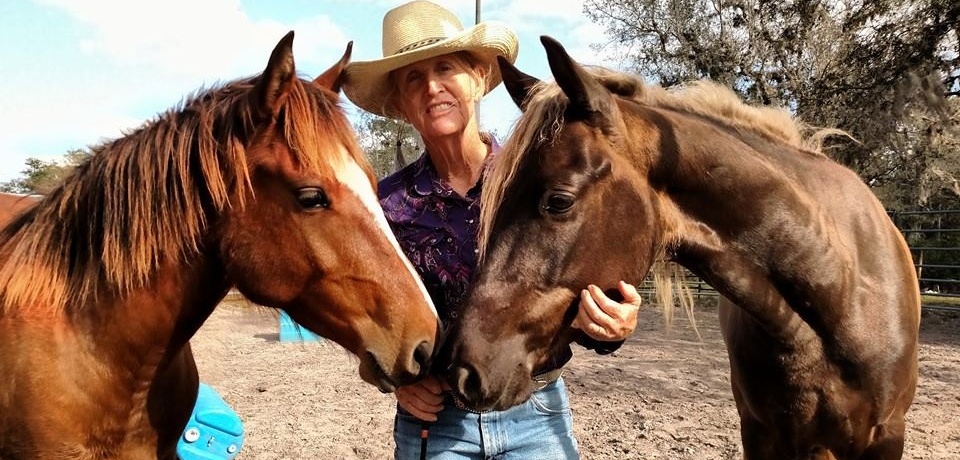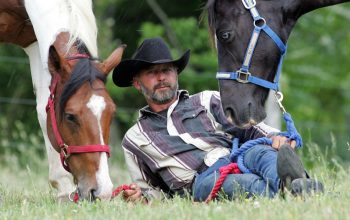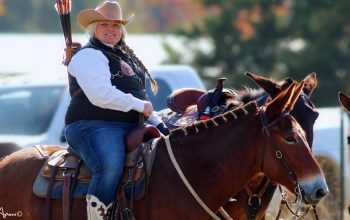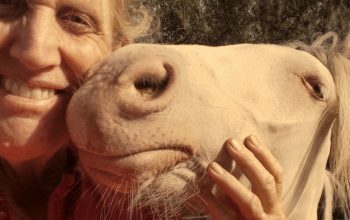Achieve Softness
By Nancy Slater, Horse Behavior Specialist
Licensed 2 Star Parelli Professional
 Pat Parelli teaches us the Nine Step Backup. Just memorize 1,2,3,4…right? Well, if there’s one thing about Natural Horsemanship you should know, ALWAYS look deeper. The 9 steps are about FEEL. You learn to feel a horse’s thoughts. The goal is the horse should feel like a hovercraft- something that floats on air, ready to travel in any direction, and at any speed. It should feel like you have the horse’s feet in your hands connected with the reins. It should feel like your horse is reading your mind…
Pat Parelli teaches us the Nine Step Backup. Just memorize 1,2,3,4…right? Well, if there’s one thing about Natural Horsemanship you should know, ALWAYS look deeper. The 9 steps are about FEEL. You learn to feel a horse’s thoughts. The goal is the horse should feel like a hovercraft- something that floats on air, ready to travel in any direction, and at any speed. It should feel like you have the horse’s feet in your hands connected with the reins. It should feel like your horse is reading your mind…
As humans, I think we can all agree that we have become desensitized. We no longer have the awareness, the feel, the raw instincts of an animal. We’re used to our normal routines, traffic jams, cell phone distractions, and lack of focus. I’ve seen many riders pull and jerk on a horse’s mouth, thinking the horse is insensitive. I’m pretty sure that is why so many people have trouble with horses. People lose their sensitivity and wonder why horses are dull or flighty.
A 20 year old rescue was sent to me for help. I immediately saw how smart, sensitive and extremely afraid of people she was. She has PTSD through her life experiences. She’s confident in the pasture; she’s boss mare. But people absolutely terrified Gem, and she became untouchable and dangerous. She is a perfect example of communication gone wrong because of lack of feel from humans.
Working with a terrified horse who is running away, causing injury to herself and those around her, kicking out in fear to avoid being touched, and closes her eyes to go into a catatonic state when escape seemed hopeless, is quite a mess to clean up. Horses like Gem want a second chance. Sensitive horses are thankful for sensitive hands.
The 9 Steps help us achieve softness.
Powerful communication tools when applied correctly
Step 1) Get your horse’s attention- Looking straight ahead, with relaxed seat and legs, gently lift the reins up with one hand until you gently feel the horse’s mouth. If you think you’ve felt it, try it again with your eyes closed to make sure! There should be no pulling on the reins by you or the horse. If your horse pulls or moves her feet, hold until she stops, then release. Your horse should not back up yet.
Ultimate Goal: your horse will get ready to ‘hover’ anytime you START to lift the reins. (She gives you a soft feel, prepares, and waits on your focus and cue to move in any direction you choose.)
Step 2) Going from loose rein to concentrated rein- While still looking forward and holding up the reins with contact, slide your other hand gently down around both reins until it touches the horse’s mane, hold both reins in that hand above the mane. The first hand then releases the reins, ALWAYS keeping the gentle feel of your horse’s mouth. Your seat and legs are still relaxed. Your horse should not back up yet.
Step 3) 2 hands on reins: carefully separate the reins between your two hands, left rein in left hand, right rein in right hand, but hold them both with your thumbs only- fingers not touching them. Hands should be low and close together. Keep the feel of the horse’s mouth. Your seat and legs stay relaxed. Your horse should not back up yet.
Step 4) These next 4 steps gently ask for a soft feel from your horse. Keep contact with the horse’s mouth; do not pull on the reins. Your elbows should be held firmly to your sides. Horse should calmly accept your touch without pulling on the reins or avoiding the contact. Slowly, with feel, close your index fingers around each rein at the same time. Relaxed seat and legs. Your horse should not back up yet.
Step 5) Slowly close your middle fingers around each rein along with the first. Relaxed seat and legs. Your horse should not back up yet.
Step 6) Slowly close your ring fingers around the reins along with the first and third. Relaxed seat and legs. Your horse should not back up yet.
Step 7) Slowly close your pinkie fingers around the reins along the the others, and wait until your horse gives you a softness in her jaw. Relaxed seat and legs. Your horse should not back up yet.
Ultimate Goal: horse gives a soft feel in both your hands, not pulling or hiding behind the bit. The feeling between horse and rider should feel good, like hand holding- soft and together.
The backup cue:
Step 8) Tuck your pelvis a little, grow tall, and pull your belly button backwards. Keep the soft feel of the horse in your hands. Now your horse should back up, because you are backing up in your body!
Step 9) Bring your elbows back and down towards the hocks.
Release the reins when you feel life in her feet, stepping backwards with no resistance.
Goal: The horse should give you a soft feel when you lift the reins slightly, and responsibly backup when you back up with your energy and seat (tuck). With a little practice, all nine steps flow together without pausing.
Imagine how nice a 9 step backup, or any other request would feel to a horse, when offered with sensitivity! How far a horse can excel depends on us. Smart, sensitive horses with spirit have the makings of Champions, yet they are the ones that usually suffer the most in insensitive hands. We need to optimize the potential of every horse.
Gem spent 2 weeks with me, and in that time, she learned to be calm, respond, communicate, be soft, and act like a partner. How? Just like a properly executed 9 Step backup, I offered her a soft feel during our sessions; I exposed the inner horse, a gem in the raw, and the makings of an discovered Champion.
 Nancy Slater is a Parelli Professional who has dedicated her life to making the world a better place for horses and the people who love them. Her self-less passion for educating kids as well as demonstrating how a real partnership with your horse can lead to competitive success is what makes Nancy stand out. We could not be more proud to be represented by Nancy as she helps us to teach horse riders, trainers and owners to use love, language and leadership to reach their goals with horses. Thank you Nancy!
Nancy Slater is a Parelli Professional who has dedicated her life to making the world a better place for horses and the people who love them. Her self-less passion for educating kids as well as demonstrating how a real partnership with your horse can lead to competitive success is what makes Nancy stand out. We could not be more proud to be represented by Nancy as she helps us to teach horse riders, trainers and owners to use love, language and leadership to reach their goals with horses. Thank you Nancy!
Pat and Linda Parelli
For more information: www.parelli.com | www.nancyslater.com
To support the Parelli Foundation’s ongoing work, please visit: www.parellifoundation.org/giving.




